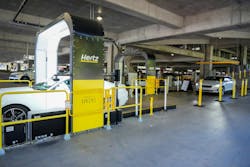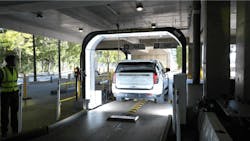From Clipboards to Cameras: Hertz Deploys AI-Powered Inspection System for Rental Vehicles
Hertz (Estero, FL, USA) recently deployed an automated inspection system in its Hartsfield Airport facility in Atlanta, Ga., to detect flaws, problems, and issues on rental vehicles.
Until recently, human inspectors completely conducted rental vehicle inspections. Technicians or appraisers would walk around each car with clipboards or tablets, visually checking for damage, tire wear, or underbody issues. This was not only time consuming—taking anywhere from 7 to 20 minutes per vehicle—but inconsistent and error prone.
UVeye (Tel Aviv, Israel), founded in 2016, is a computer vision company that specializes in automotive vehicle inspection systems. The system they have implemented for Hertz is a drive-through platform utilizing cameras and AI software to perform exterior inspections of rental vehicles.
VSD reached out UVeye for further information. The following is a Q&A with Yaron Saghiv, Chief Marketing Officer.
How does the inspection process work?
A vehicle drives through a UVeye inspection system. The system uses a combination of flash lighting and more than 20 high-resolution, high-speed, AI-powered cameras that are strategically placed to scan the vehicle’s tires, underbody, and exterior and accurately capture detailed imagery in various lighting and environmental conditions. This ensures complete 360-degree imaging as the vehicle moves slowly through the inspection station.
Captured images are then transmitted to cloud-based servers where UVeye’s AI software processes them in real time. The system is designed for secure and efficient data transfer, but the exact configuration may vary by deployment. The images are processed by UVeye’s deep learning models, trained on millions of vehicles to detect tire wear, leaks, rust or other exterior damage.
Related: Porsche Adds AI-Enabled Robotic Paint Inspection System
Related: AI Vehicle Inspection with Ultra High Resolution Cameras
What kind of computer and software is used?
All the core software is developed in-house by UVeye’s engineering and AI teams. The platform combines computer vision, deep learning, and diagnostic logic, built specifically for automotive applications and based on millions of vehicles. The system automatically detects, classifies, and flags anomalies like worn tires, dents, rust, and leaks.
Once the image data is processed, what happens next?
Once analysis is complete, results are sent to a dashboard where dealership or fleet staff can review them within a few moments. Vehicles are tagged with condition reports, scan images, and timestamps. Depending on the case, that data may be used to create appraisal quotes, support reconditioning, document policy claims, or send customers automated inspection reports. The system also generates insights over time, such as identifying repeat damage patterns or pinpointing high-performing service lanes.
What were some technical challenges and how were they addressed?
One of the biggest challenges was ensuring the system performs reliably in all conditions, whether it's snow, rain, dust, or low light. UVeye solved this through a combination of weatherproof hardware, proprietary lighting systems, and the work of field teams who visit every site, analyze environmental factors, and plan precise layouts to ensure optimal placement.
Another challenge was integrating into existing workflows which required close collaboration between UVeye’s product, integration, and partner teams, who built custom APIs and platform connections designed to eliminate friction and ensure a smooth rollout at every location.
What have been some results or benefits of the new inspection system?
The biggest impact of UVeye’s inspection system is a faster, smoother experience, from quicker service check-ins to more transparent trade-in evaluations. Every scan is time-stamped, photo-documented, and consistent, removing guesswork from the process. At service lanes, it shortens wait times and gives customers a clear visual record of their vehicle’s condition.
Are there any statistics on accuracy rates or increases in numbers of vehicles inspected vs. time per inspection?
UVeye identifies 96% of vehicle defects, in comparison to only 24% identified in manual inspections.
What’s next? Are there any plans to implement more of these systems?
Yes, UVeye systems are being adopted more widely across North America and Europe from dealership visits to rental returns and pickups. Several leading automotive brands are now working with UVeye to standardize these inspection lanes across their networks, helping ensure every customer receives the same fast, transparent, and trustworthy service no matter where they go.
About the Author
Jim Tatum
Senior Editor
VSD Senior Editor Jim Tatum has more than 25 years experience in print and digital journalism, covering business/industry/economic development issues, regional and local government/regulatory issues, and more. In 2019, he transitioned from newspapers to business media full time, joining VSD in 2023.


